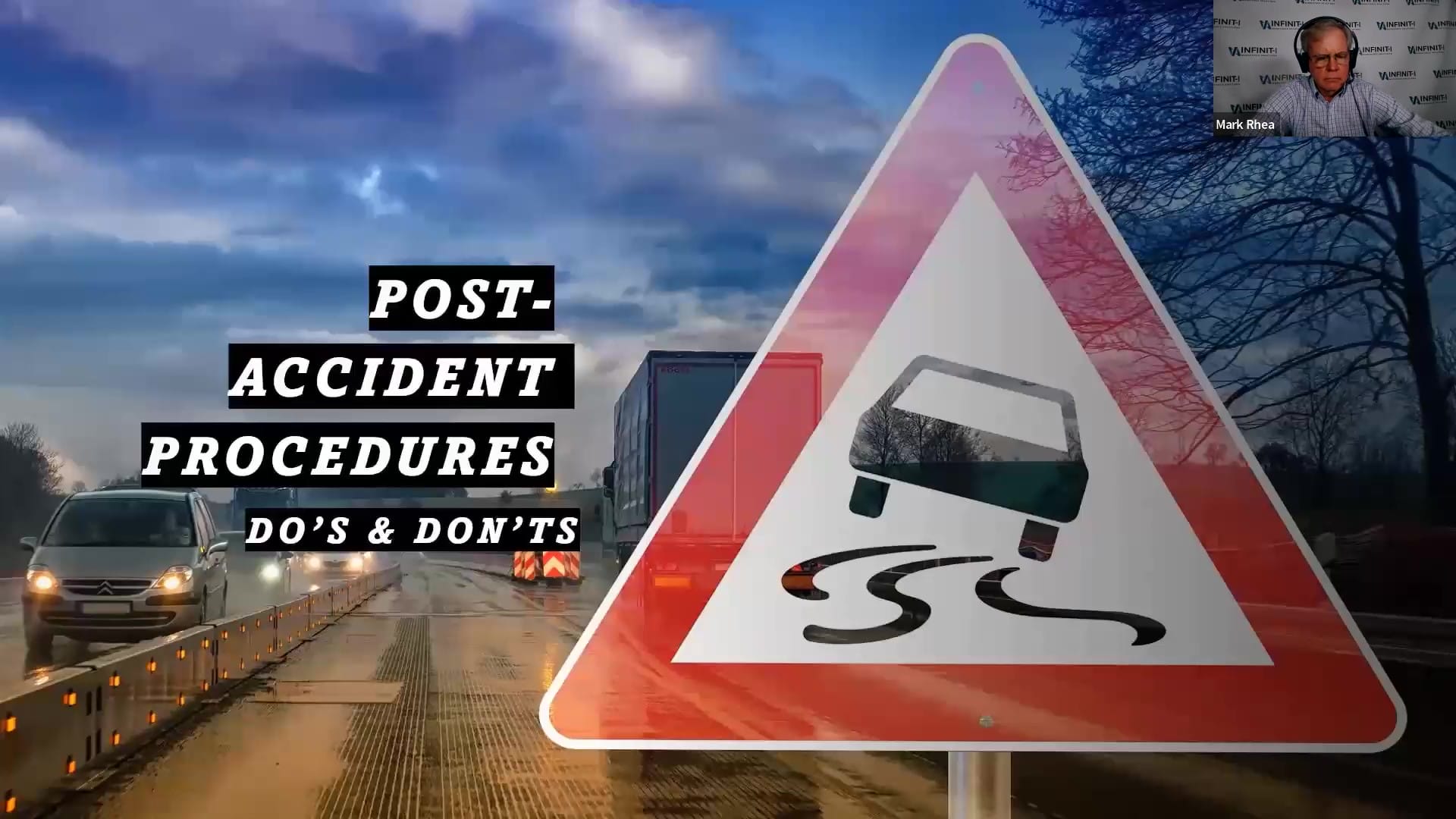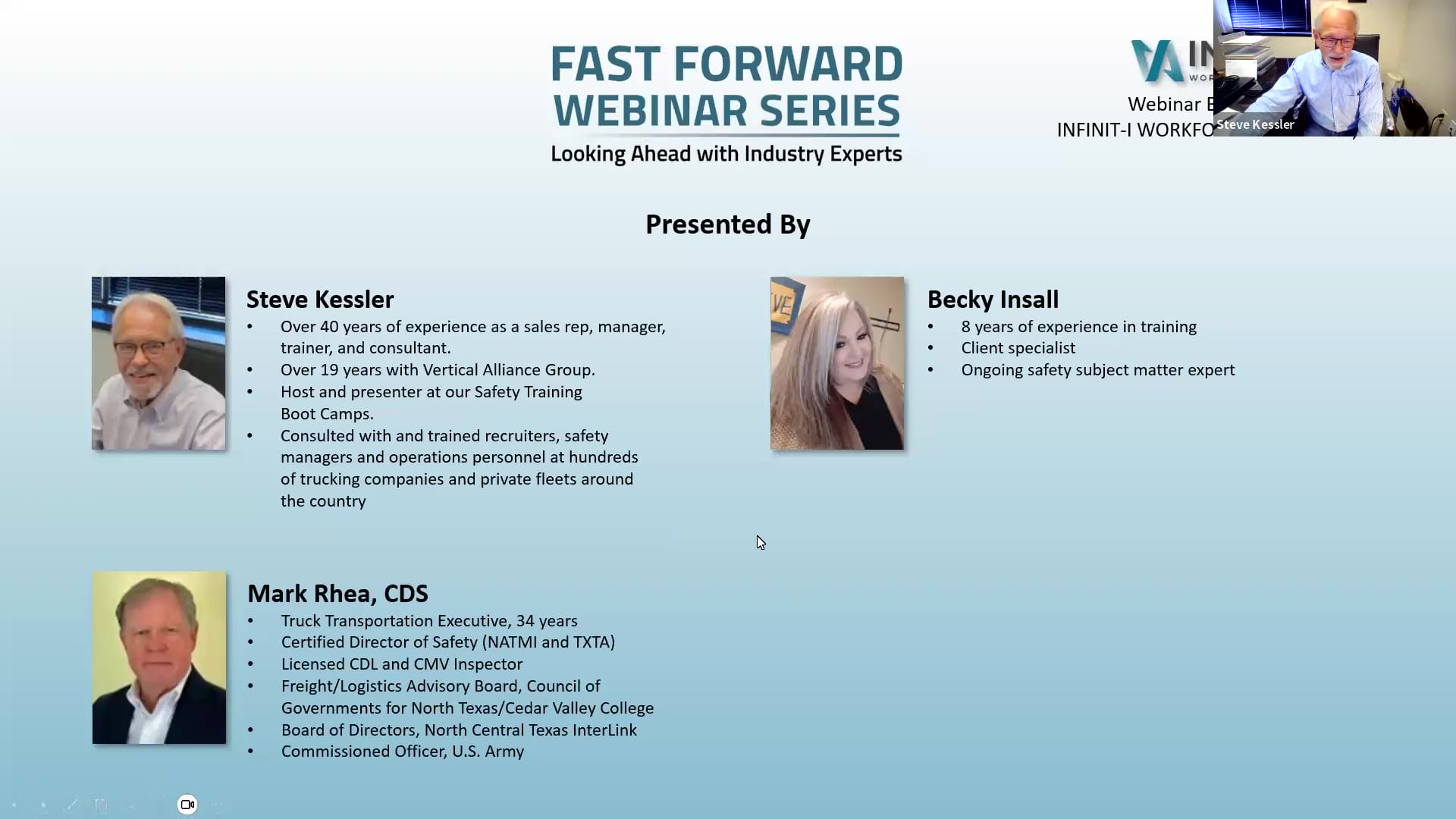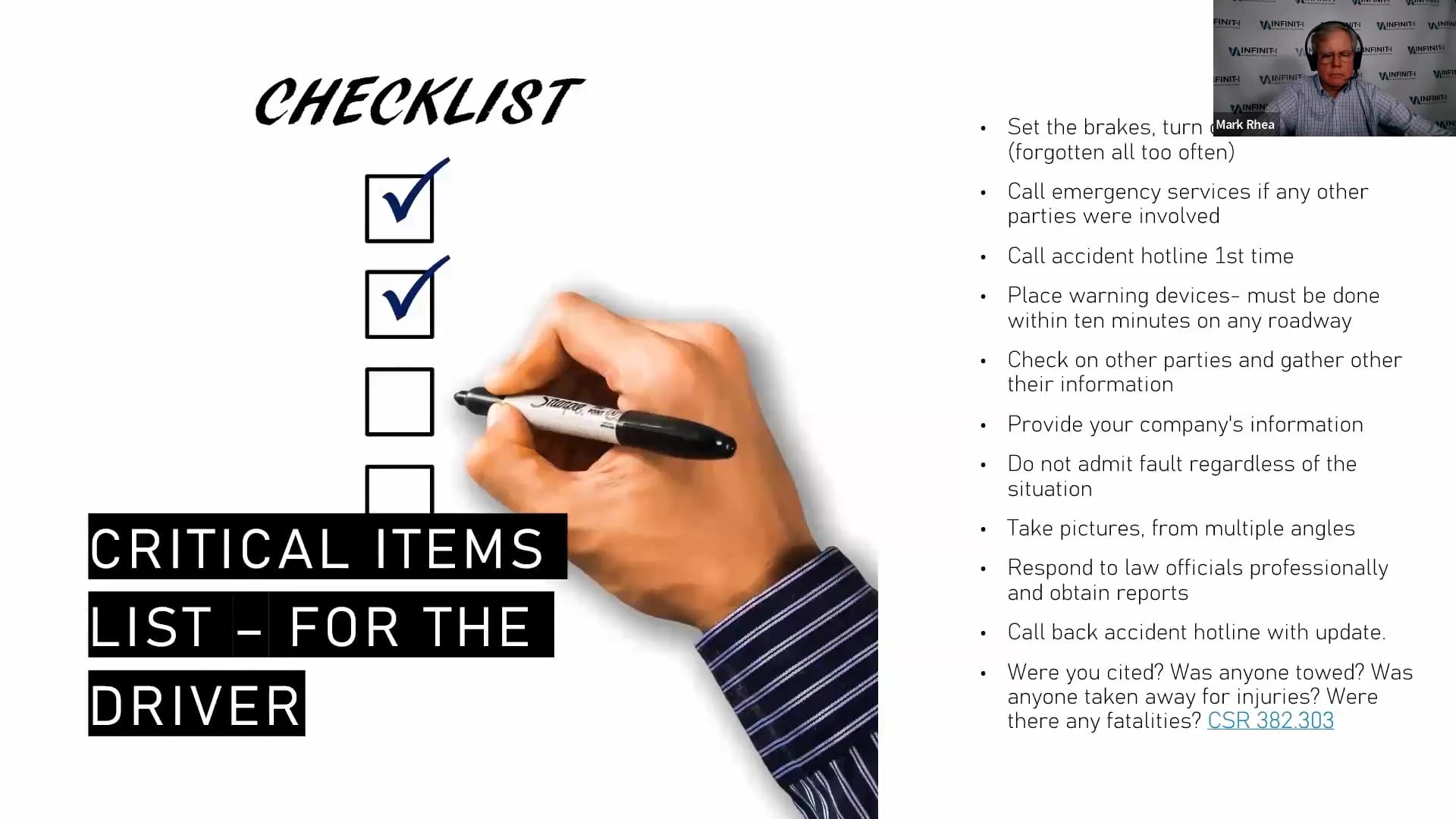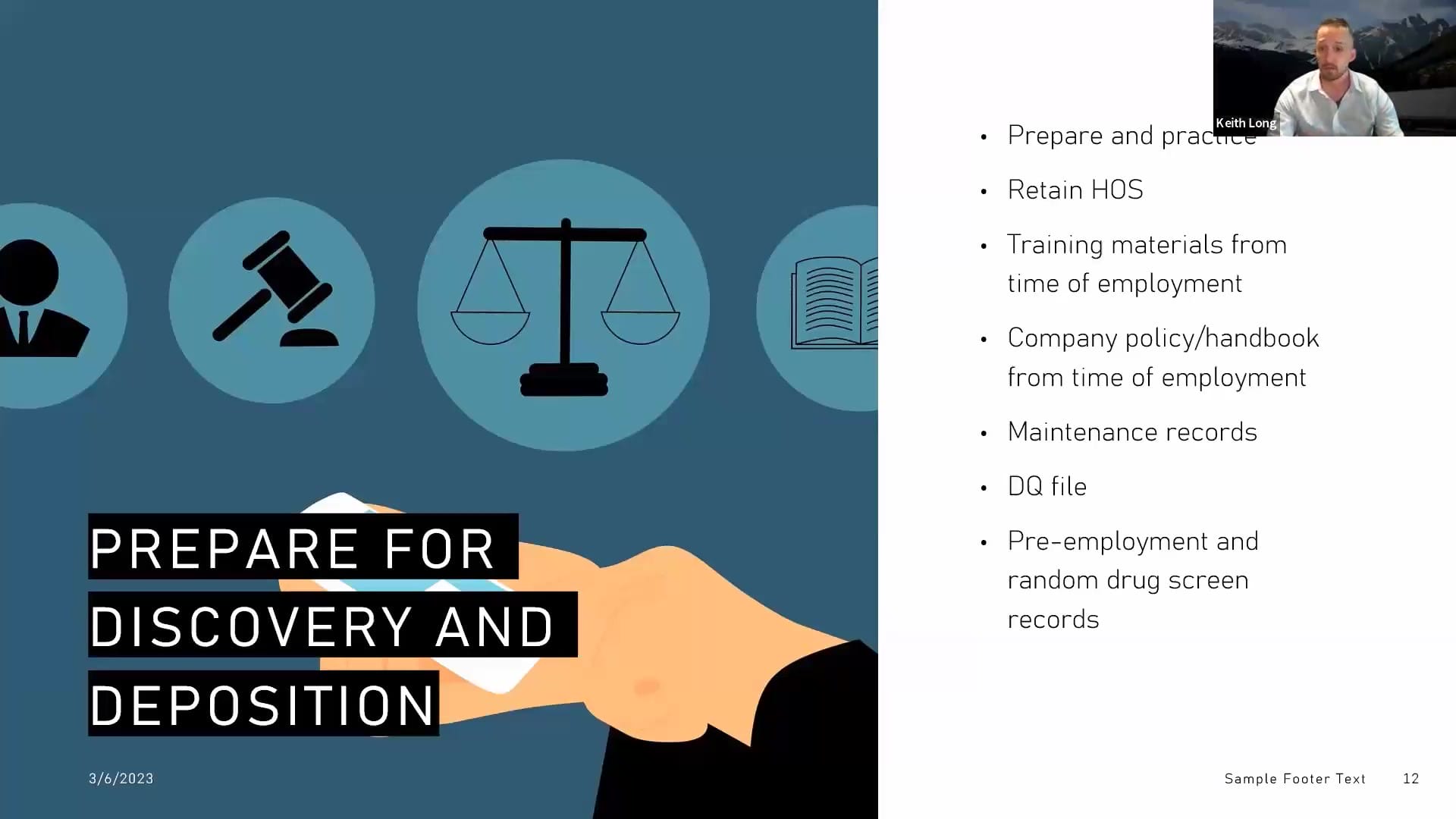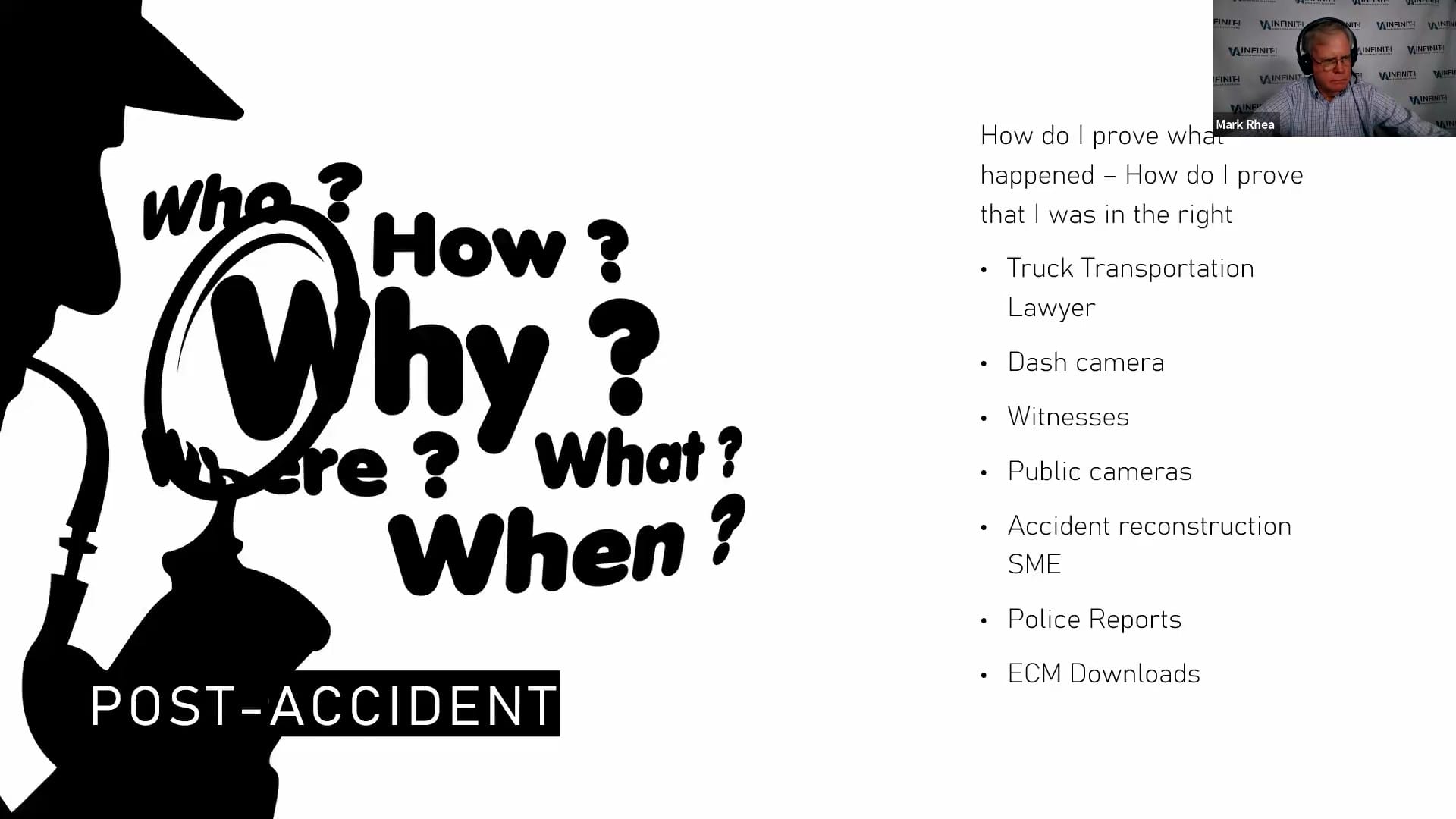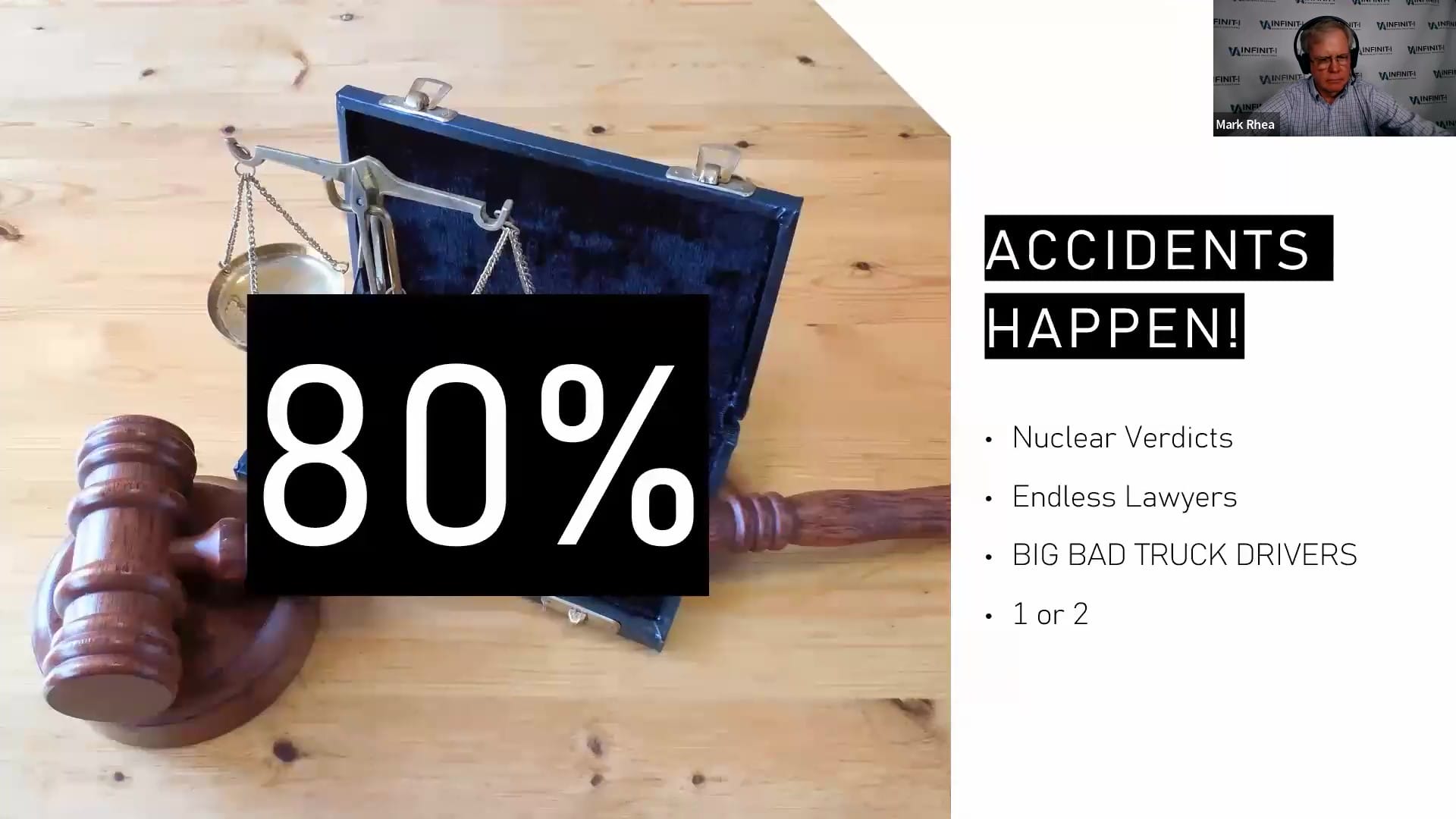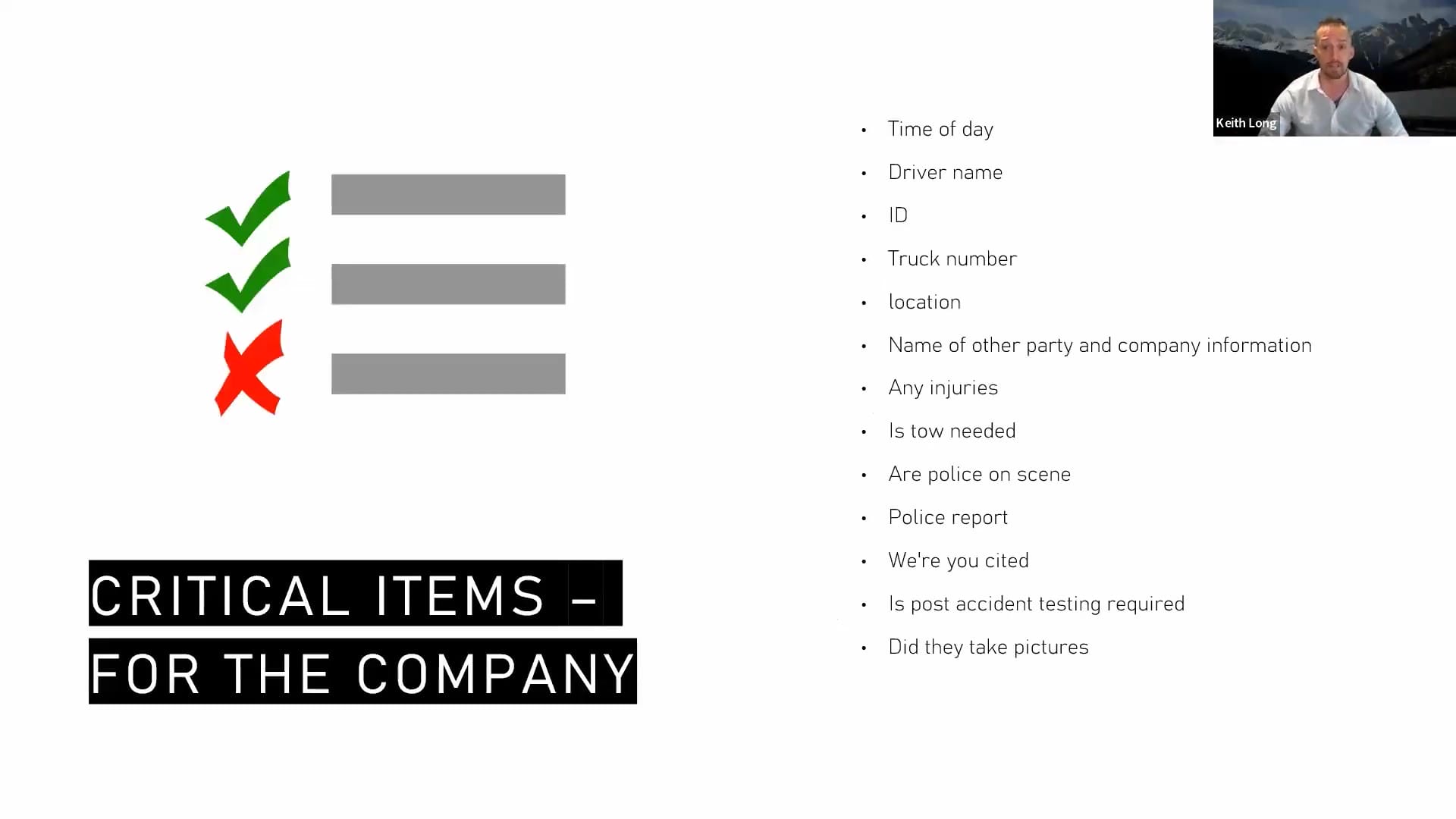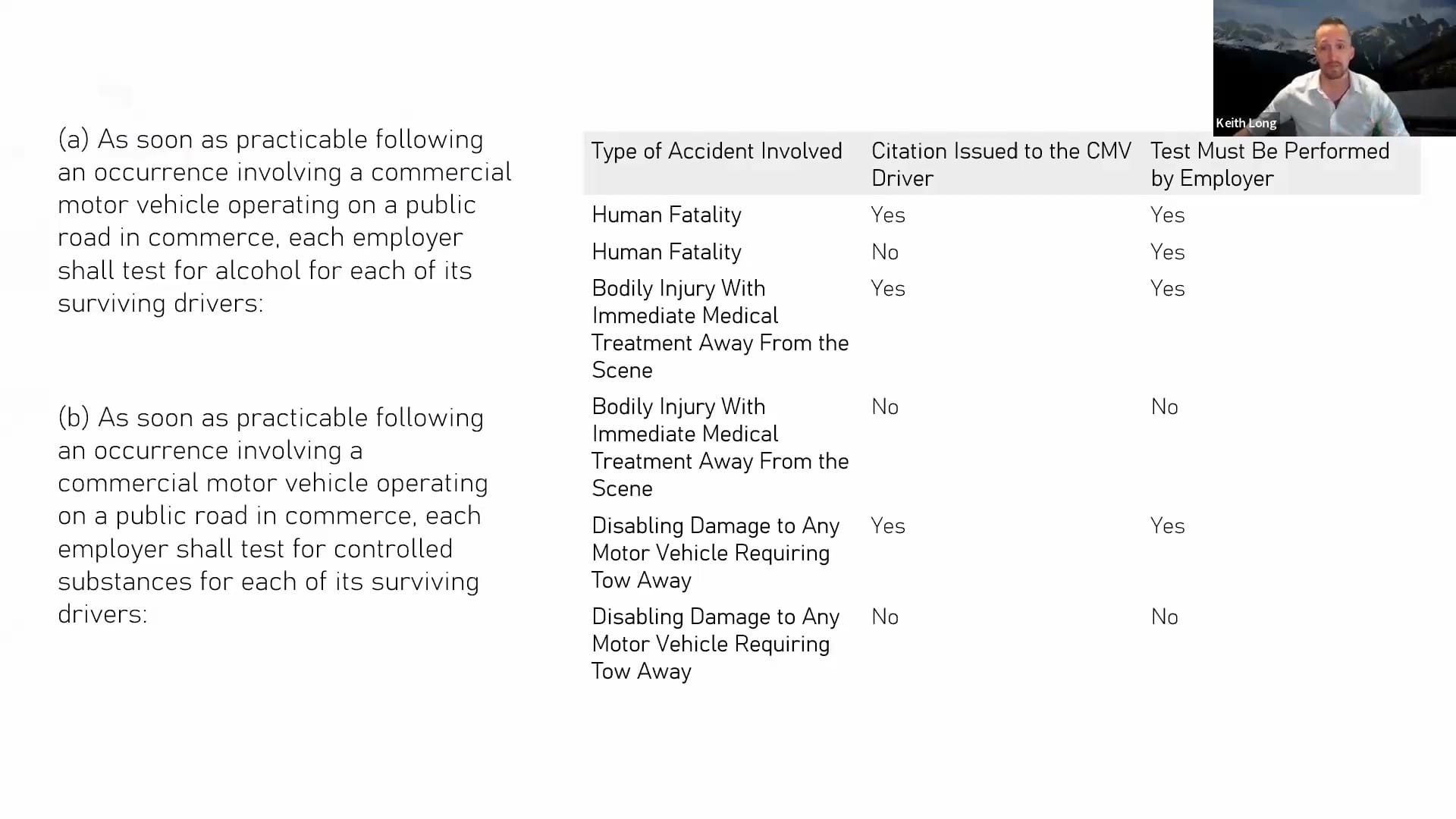Transcription
1
00:00:03.490 –> 00:00:09.099
Steve Kessler: Good morning. Everyone. Welcome to the Infinit-I Fast Forward Webinar Series.
2
00:00:09.150 –> 00:00:35.450
Steve Kessler: Appreciate you all being here this morning. we got a really good topic today, I think something in this industry. it’s not if you’re gonna have an accident. But when and very often, when there is an accident that could generate a lawsuit. So our topic today is about at the scene of an accident. Post accident procedures what to do and what not to do.
3
00:00:35.470 –> 00:00:46.319
Steve Kessler: So I think it’s a it’s a very important topic. It’s something that companies should train their drivers on what to do when these accidents do happen.
4
00:00:46.420 –> 00:01:00.349
Steve Kessler: and so once again, I’m glad you all decided to join us today, if you don’t mind jump into the chat to Tell us who you are and who you work for, and maybe where your where you’re seeing is from.
5
00:01:00.410 –> 00:01:14.420
Steve Kessler: And now, while you’re doing that I got a couple of folks that I want to introduce to you joining us this morning is is Mark Ray some of you. If you’ve been in our webinars in the past marks a regular on our program.
6
00:01:14.420 –> 00:01:33.759
Steve Kessler: he is a truck transportation executive for at least 35 years. I know Mark for a long time. he’s a director of safety is a license. Cdl, cmv, inspector. I don’t know if anybody in the industry that has more experience in what we’re gonna talk about today than Mark.
7
00:01:33.840 –> 00:01:41.349
Steve Kessler: By the way, folks, you should know, this is going to be a replay of the webinar we did on this topic not very long ago.
8
00:01:41.570 –> 00:01:57.849
Steve Kessler: I also want to introduce you all to Becky Insall. Becky is one of our national account reps she’s an experienced person in in training and client specialists. So welcome, Mark. And Becky.
9
00:01:58.090 –> 00:02:14.490
Steve Kessler: thank you, Steve.
10
00:02:14.490 –> 00:02:31.730
Steve Kessler: just type it in there, and when we’ve finished looking at the webinar, we’ll try to answer any of the questions that you all may have through the course of the of the recording here. So if you all are ready, we’re gonna start the webinar.
11
00:02:34.890 –> 00:02:45.059
Good afternoon and welcome to the Infinit-I Webinar Series. Today we have a fantastic topic and guest speaker.
12
00:02:45.190 –> 00:02:48.609
Our topic for the day is at the scene.
13
00:02:56.420 –> 00:02:57.470
Steve Kessler: What happened?
14
00:03:06.320 –> 00:03:16.479
Mark Rhea: Good afternoon and welcome to the Infinit-I Webinar Series. Today we have a fantastic topic and guest speaker.
15
00:03:16.620 –> 00:03:35.439
Our topic for the day is at the scene. Post accident procedures what to do. what not to do. we’ve got joining us, Mr. Keith long the transportation nerd a subject matter expert that’s going to give us some insight on
16
00:03:35.580 –> 00:03:48.710
his experiences, and how we can communicate what to do at the scene with our drivers, as well as what to do at the scene behind the scenes as an administrative staff.
17
00:03:49.030 –> 00:04:05.759
I want to make sure that we can cover a couple of real important facts is the majority of the car. Commercial truck accidents are. The critical reason belongs to the car, not the truck.
18
00:04:06.000 –> 00:04:16.760
The unfortunate is the ability to defend and present that in a format that a defense attorney can can defend the case, and
19
00:04:16.810 –> 00:04:31.870
it’s very frustrating when it’s clearly a non- preventable. But you’re unable to make those determinations and some of the things that are done immediately at the Scene Post acts and procedures can certainly help
20
00:04:32.020 –> 00:04:46.080
with defending that lawsuit. So without anything else. Keith, thank you for joining us today. Yep, yep, absolutely glad to be here and super excited about about this topic. So there’s there’s there’s a lot here to chew on
21
00:04:46.690 –> 00:04:57.979
fantastic. Why don’t you want, you just kick it off and tell us about what some of our audience can do and not do. Immediately
22
00:04:58.050 –> 00:05:16.979
post accident. Great! Great! Well, and you know you really hit it on the head there, right according to the at a. So they did a study. They had the 2021, or concluded a study, and found that 80% of accidents involving a commercial motor vehicle and cars.
23
00:05:16.980 –> 00:05:35.969
the cause of the accident can be attributed to the driver of the car or the passenger vehicle rather than the truck driver. Right? So 80%. And that’s that’s why. Here, you know, we can say that a majority of these cases are defensible, right? And if you’re not
24
00:05:37.130 –> 00:05:49.019
defending yourself on these cases, you’re you’re wasting time, and you’re leaving yourself out there. But, as you said, it is critical what you do in those moments after the accident. Right?
25
00:05:49.610 –> 00:06:02.639
we’re really in. And I, you know we’ve probably heard the term quite a bit. But we’re in the age of nuclear verdict when it comes to truck transportation right? These are those high
26
00:06:02.870 –> 00:06:13.629
awarded cases, high jury awarded cases that may surpass what may be reasonable or rational for the accident itself.
27
00:06:14.350 –> 00:06:31.590
So and you probably see it all the time you’re in any major city. Right? Yeah. You take a trip down the interstate and you see the big signs right? I’ll get you millions. My last case I made 10 million or or you know you name it. They’re going to promise big numbers and for
28
00:06:31.770 –> 00:06:45.270
you know any any lawyer they’re going out after these cases, and that the goal is right. If you don’t have your facts straight. you didn’t do your due diligence, you know, after that accident, then there’s opportunity there for
29
00:06:45.620 –> 00:06:59.169
well, us to pull it the heartstrings of of the jury right, or turn this into a sympathy case rather than a facts. What? What? What actually happened? they they play on the idea of
30
00:06:59.440 –> 00:07:20.199
big, bad truck drivers. And that’s, you know, when we talk about this 80% statistic, that’s just not it right. And those facts of post accident, they get a little more hard to focus and hard to find as the crash or as the case. ages. Is that correct?
31
00:07:20.310 –> 00:07:45.170
Right? Right? Absolutely the the the farther we get away from it a lot of that information is disappearing right? There’s, you know, we talk about super important things, and we’ll we’ll we’ll mention this here in a little bit. But the Ecm on a truck right? That electronic control module that tells the entire story of what’s going on with that vehicle. If we’re not getting that information right away, it may very well be gone
32
00:07:45.200 –> 00:07:54.139
when you go to look for it months down the road, or, you know, with with the way cases can go now, even years down the road. Right?
33
00:07:55.700 –> 00:08:13.070
Yes, and I’ll just. You know, the the. The reality of these nuclear verdicts is real. I I’ve certainly been involved in some, and they are alive and oil right? Right? And it’s it’s, you know, it’s one or 2 missing things that that create that opportunity.
34
00:08:13.390 –> 00:08:25.109
For, you know, an attorney to hold on to right. And really. I mean, sway the jury and and and just a little bit right? So we’ll talk about some of those things here. So
35
00:08:25.510 –> 00:08:52.570
really. how do we prove what happened, and how do we prove that we were in the right? And and this all starts with one, you know, making sure we’re doing what we need to after the accident, but to making sure you have the right person representing you when you’re out there, right? We’re not just going to get any lawyer. We’re going to get somebody that has experience in the industry that’s been in and around it, and might as well be their specialty right? A transportation lawyer.
36
00:08:52.970 –> 00:09:21.639
are you using dash cams? You should be, especially in this day and age. at least an external camera. But if if you’re using internal cameras. This also tell the story of, you know, if we’re saying our driver was in the right, then we’ve got that visual that shows our driver was hands at 10 and 2 not distracted, you know, maintaining our lane where we needed to be when we needed to be there. Right?
37
00:09:22.630 –> 00:09:51.530
So at the scene right? We want to be sure that we’re any witness statements. seek out and look for any public cameras. If you don’t have a dash camera or anything like that on your trucks a lot of times. You’ve got cameras in the area local businesses nearby gas stations. If your accident happened at an intersection. Right? You may have intersection cameras, and a lot of times what we’ve seen is even passer buys might have a camera on their vehicle.
38
00:09:51.730 –> 00:10:02.289
right? That are that are willing to submit that. there’s also public cameras in intersections. And yeah, like polls or everywhere, aren’t they? Yeah, absolutely. Absolutely.
39
00:10:02.550 –> 00:10:18.190
Now, on on the witnesses. I know I’ve had this happen where you had a statement. and you get down the road and you begin to put the defense together. And you. Now you can’t find that witness right?
40
00:10:18.550 –> 00:10:42.970
Right? Yep, absolutely. So it pays one to get that whip witness statement, but to to keep up with them and keep track with them right? Right? make sure you’ve got a foundation of contact with them, especially if if if it’s a key witness, right? Somebody that was really there when it happened. It’s it’s important that you don’t lose contact with them, because that may very well be the foundation of that case surviving.
41
00:10:45.970 –> 00:11:00.050
get with a good accident, reconstruction, subject matter, expert right? Somebody that that is well versed in doing this because their goal and their their job is to take
42
00:11:00.570 –> 00:11:24.849
all the facts of the accident and put together a retelling of the event. You don’t want to rely on just the accident description that we get from the police report. It pays to also have somebody look at it third party, and and and reconstruct it as well. Right? We also kind of get a play by play and an opportunity to to determine what was going on at the moment that the accident happened.
43
00:11:26.420 –> 00:11:38.699
and again. always get that. Ecm data right? Don’t don’t let that fall by the wayside. That should be one of the first things that you are doing right. If that trucks.
44
00:11:39.120 –> 00:11:54.759
you know, ending up, being towed away from the scene, or anything like that. You need to make sure you’ve got somebody on the receiving end of that to get that Ecm data that should be top and first priority. Aside from other things that might be going on at the scene.
45
00:12:01.770 –> 00:12:19.390
there’s a lot of things that as a driver we need to be paying attention to right. There’s a lot of things directly after that accident, those those first critical minutes after that accident that a driver should be paying attention to and be ready for.
46
00:12:20.360 –> 00:12:45.970
So at the scene of next to right. Let’s let’s let’s get in the mind of a driver in the accident. What happens? Where, naturally, like anybody, we’re panicked. Right? You’re you’re you’re sergeant racing. It’s the rental is flowing. That’s it. That’s it, exactly. And if somebody is not telling you what to do in those moments, it’s easy to forget what you’re supposed to do, or if you don’t have a checklist right in front of you. It’s easy to forget
47
00:12:45.970 –> 00:13:04.019
what you should be doing. So, First and foremost, I recommend having a checklist in that truck, a laminated checklist that driver knows where to go to, whether that’s that’s pinned to the dash or attached to the visor right? Something that that driver can follow step by step
48
00:13:04.130 –> 00:13:15.939
every single time, and and you should really have company training on it. Right? Don’t just rely on an accident happening to hope that they follow that standard operating procedure, right
49
00:13:15.960 –> 00:13:21.980
practice makes perfect right. We we train for all kinds of things. And this should also be one of those things that you’re training for.
50
00:13:23.160 –> 00:13:40.799
So you see here, in the event of an accident, right? Set the brakes turn on the four-way flashiers, and, as the Cdl. Manual says, right secure the area right? And and so when we’re talking about securing a scene, the way that a driver does that is
51
00:13:41.380 –> 00:13:53.740
placing out those emergency triangles within the first 10 min. contacting the authorities and making sure right or checking on other parties. That is at the scene.
52
00:13:57.120 –> 00:14:23.120
If we’re not looking at, you know, I I think in general, it’s important one to note here, too. that we do reach out to the authorities for any accident. Right? It’s important that you do so unless it’s your driver. And and they hit a cement block and a parking lot right? Or they did some sort of landscaping. We we’ll we’ll call it that. But if any other parties are involved, it’s important that we get.
53
00:14:23.150 –> 00:14:34.099
You know the the police involved, or some sort of law enforcement motor vehicle, enforcement division, an official person who can be there to respond to the scene and take record of the scene.
54
00:14:34.410 –> 00:14:51.040
So you recommend actually asking the other party, are you? Do you need medical attention? And if that answers, Yes. you 9, 1 1 one am in, but but but check on the other, the the the other party on on their health and well-being.
55
00:14:51.350 –> 00:15:10.509
Right? Right? And again, you know, this really does fall into the and into the. I guess best way to put it right. We’re not going to intervene. Right? That’s that’s that’s not our job. We’re leaving that up to the professionals right? But it it is important to assess that scene and understand if if there is anything critical
56
00:15:10.650 –> 00:15:22.729
but regardless, we should be getting official help on the way. Yes, we we should show sincerity and and compassion. But The other thing, I think, is important. We need to assume the other party.
57
00:15:23.120 –> 00:15:49.539
as their iphone on is recording. Everything is going on. So going to the window and using some vulgar language and making the accusations probably is not a good idea, right? Right? Absolutely. Professionalism is is key here, and it should always be. you know, at the first of mind in these situations. you know it’s important to check on other parties, but you know I’ve I’ve
58
00:15:50.280 –> 00:16:05.549
or the driver And an axe and say it. you know is anybody dead? But that’s probably not the response that we want to go to the window with. And I think that’s what you’re talking about. There. Mark is You know how we assess the instant we’re not
59
00:16:05.650 –> 00:16:18.990
there to to offer aid or anything like that. We’re there to make sure that everybody is is okay, and that you know. yeah, your help is on the way. We’re not going to try that case on the side of the road. That’s right. That’s right.
60
00:16:19.620 –> 00:16:39.650
in general, you know, we always say do not admit fault right, and and the reason being there is because we have no clue. What what the other factors are in that accident you have no clue. What else was going on? If your rear ended at an intersection, and the light was green in front of you. You might say you’re you’re impeding traffic, but
61
00:16:39.650 –> 00:16:56.119
you don’t know that driver behind. You could have been on their cell phone they could have been speeding, they could be inebriated. There’s all kinds of factors that go into an accident, right? So best thing to do is to stick to the facts and know where you were when when the accident happened.
62
00:16:57.010 –> 00:17:21.400
Right? We should be calling into our company the moment it happens, right. After we’ve contacted the authorities, we should be calling our company and letting them know we’ve been involved in an accident so that the company can start that that proper chain right? That proper order of operations, to get what they need for the accident? and and to make sure that you’re doing what you need to at the scene as a driver.
63
00:17:21.450 –> 00:17:37.269
Right? So you know, if anybody’s injured, if anybody cited, or anything like that as a company, there’s things that we need to make sure happen. so that we’re covering ourselves in the event that this does have some legal ramifications.
64
00:17:38.140 –> 00:17:50.850
So you know, we talk about. Let’s say, post accident, drug and alcohol. That’s one of those critical factors that if you didn’t get that taken care of in the allotted amount of time.
65
00:17:51.240 –> 00:18:09.380
Right? That’s that’s that’s the type of thing. But then we we we go to court later on, and it’s a non-defense point, right? That you can say. Well. was your driver inebriated? Was your driver this or that? We don’t know, because we don’t have this evidence here, so we leave the door open for suspicion.
66
00:18:10.060 –> 00:18:27.299
if you don’t know the rules and regulations right, we should be understanding and knowing. Csr, 3, 82, 3, right that that defines when and where, or in the event of an accident, what should be happening for
67
00:18:27.420 –> 00:18:37.379
post-acent drug and alcohol? If people were toed away from the scene? If people were injured at the scene And and the windows in which those things need to be done.
68
00:18:38.420 –> 00:18:53.109
Now this this is a pretty long list. Let me just ask you a tough question is, is the is it trainable for a a motor car to be able to train their drivers on what to do at the same.
69
00:18:53.180 –> 00:19:09.260
It is trainable in. Yep, absolutely. It is right. There’s there’s because it, you know, like like we said here, if I just threw this list at you, and you’d been involved in an accident, and you’d never looked at this except for your break the glass moment.
70
00:19:09.420 –> 00:19:32.600
right? And you’re gonna have a problem. Right? You’re you’re probably not going to follow through with everything that you need to, even though it’s right there on paper. We have to train to it. you know, if in an office building, we train for things like emergencies and fires, right? We have standard operating procedures that we follow, that we’re required to train on. It should be the same for our drivers that we have out in the field.
71
00:19:33.640 –> 00:19:47.249
Yes, and and I’ve heard this over and over when when you get to the deposition stage. Nobody told me. Nobody told me to do any of these things, and that that’s a preventable that that needs to be correct.
72
00:19:47.380 –> 00:20:03.570
Right? Right? Absolutely. Absolutely. pictures. Pictures are a big one. Yeah, make sure that you document get pictures that support and tell the story. Pictures should have.
73
00:20:03.620 –> 00:20:16.299
you know, trailer numbers tractor numbers in them. They should be far enough back that they tell us the story of the accident we get. We get a lot of these, and I’ll show you a good good one here.
74
00:20:16.370 –> 00:20:26.589
a lot of these that look like this. Yeah. And and what does that tell you? Right? We we know that there’s damage disabling damage. But this doesn’t tell us
75
00:20:26.660 –> 00:20:42.209
any other part of the story, and and you get these all too often right. We’re not taking pictures so that we can send it to our claims, adjuster and and determine when I can get my car into the next shop right? We we want pictures that tell the story, because at the end of the day
76
00:20:42.550 –> 00:20:53.250
you may very well have a party that has no clue. What happened except for the facts that are set in front of them, the pictures and the story that’s been written out So
77
00:20:53.650 –> 00:21:08.179
more appropriate view, right? Looks like this. Right? We we can tell how close we were to to the curve or any other object we can see in the back of this picture that we’re just on the other side of an intersection.
78
00:21:08.660 –> 00:21:30.580
We get the license plate. We get the make of the vehicle we get what Lane position the vehicle’s in. There’s a whole lot more to this story now. but another opportunity then would be to to take a picture on the other side, right out and around. Most important thing to do, though, is make sure you’re not endangering yourself.
79
00:21:30.880 –> 00:21:43.640
stepping out in traffic or anything like that to get these pictures. That’s that’s That should be a no-brainer, but absolutely needs to be set another good one here a good attempt right? But but there’s not.
80
00:21:43.860 –> 00:22:03.779
We don’t get a whole lot of the story here. and you can see we’ve got maybe a whole trailer number there there in the corner, but but that is one that that you’ll see right. We’ll get a partial of a number or something like that, right if we don’t see where it begins and where it ends. That doesn’t tell the whole story. Picture that license plates very important.
81
00:22:03.830 –> 00:22:19.210
correct, and and that and I’ll I’ll assume that would include any eyewitnesses if you can get a a picture of their losses, flight absolutely right, because that that ultimately furthers your ability to to reach out to them or stay in contact with them. Right?
82
00:22:22.040 –> 00:22:33.499
So here’s that regulation right? Post accident, drug and alcohol testing again. Extremely important, right? This. The Csr. Tells it all.
83
00:22:34.250 –> 00:22:46.500
You should be familiar with what to do. Addison, what to do. Post accident, and you you should know what the Fmcsa. Says that we should be doing what rules we should be following.
84
00:22:48.980 –> 00:22:53.150
because failure to do so here it looks like we chose not to.
85
00:22:57.090 –> 00:23:14.019
So for the company right? This is the receiving end of that phone call. Right? Things. We we need to be paying attention to right? What’s the time of day? What’s the driver’s information? What’s the driver? Id truck number, location? Other parties involved in their information?
86
00:23:14.210 –> 00:23:25.189
Right? Are there any injuries? Have we called the authorities our toes needed. Has anybody been told yet? Have officials responded to the scene yet?
87
00:23:26.120 –> 00:23:37.289
Did you get a police report because we should be? And were you cited. That’s another big one there especially, you know, at at an accident we can
88
00:23:37.320 –> 00:23:52.419
be cited and not be in the wrong, and that decision can come later. but if if you’re cited, that’s also something we can go back in data queue right? There’s there’s an opportunity there. If we’re if we’re at fault for for a specific reason.
89
00:23:52.990 –> 00:23:58.280
and we talk about those Csa categories. Crash! Right? This. This is where that comes in
90
00:24:00.290 –> 00:24:26.180
post, I assume hazardous, hazardous spills would also be an important item. Right? Right? Absolutely. If you are in hazardous transportation. that’s that’s a whole. Another thing. There, right? We should be looking at our at at our guidebook, and determining, based upon what we have, how we need to handle the instant and you should also be communicating with the authorities what is being hauled on that vehicle? Right?
91
00:24:29.300 –> 00:24:49.369
And then that to further that point right. If we go back to what the driver should be doing. in that case, right? That that er g the emergency response guide tells the driver right how far they may need to block off an area depending on You know what chemicals or what products are on that vehicle.
92
00:24:49.370 –> 00:25:09.629
and the type of things that they should be carrying with them in the event that that happens. So that really sets off a whole secondary chain to this, that a whole, another set of steps that our driver should know and should be ready to follow, and as a company we should be practicing with them. If we’re in that mode of the industry.
93
00:25:12.600 –> 00:25:26.420
So like we’ve been talking about here market. Really, all comes down to preparation and practice right ultimately, the end of it. If if this goes to, if this goes to trial or is going to
94
00:25:27.040 –> 00:25:38.549
we to prepare for discovery and deposition. Right? We should be practicing. If you’ve got a good truck transportation lawyer. they’re going to be putting you through
95
00:25:39.040 –> 00:25:50.439
deposition practice. be prepared to block off your calendar for for some time there, because that does take a while, especially if you, if you’ve been through it. You understand. There, but
96
00:25:50.550 –> 00:26:02.559
you know you, you have to be ready for it, and you should also be well and familiar with things like your company’s training materials. company policy and handbook.
97
00:26:02.580 –> 00:26:18.590
you know. The one key thing right here is. if I’m defending an accident that happened 3, 4 years ago. The company policy and training materials at that time that were provided
98
00:26:18.790 –> 00:26:38.640
are what you’re defending. Right? You’re you’re not. It’s not current place and time. So it’s important to be familiar with training materials that would have been handed out at that time, and it’s important to understand and be knowledgeable of the company policies that were in place at that time, and what materials you put out at that time.
99
00:26:39.050 –> 00:26:57.119
because just as much as you’re going to know it. You can guarantee that the other party right. The other lawyer, is going to know it just as well as you do. Absolutely important to retain hours of service records, where, in the the Ecm. Tells us the entire story of of the truck and what happened in an incident.
100
00:26:57.160 –> 00:27:15.730
the hours of service tells us the story of the driver and and and what happened prior to the instant right sleeping habits, driving habits. Right? You can look in there. pre accident! You might be determining, you know, potential for fatigue. You might be
101
00:27:15.730 –> 00:27:32.389
determining. What was this driver off for a while before they got back on the road. There’s a whole lot that this hours of service tells. It also tells right. Were they doing their pre and post-trips the way that they should have been? Or are they inspecting their vehicle? Is that notated?
102
00:27:33.440 –> 00:27:59.810
Because if a driver is not paying attention to those things right, the argument could be made. But what else aren’t they paying attention to? Could this also have been a contributing factor to the accident? Right? Yeah. And and a lawsuit can be can be filed well past the 6 month deadline for retaining hours of service. But if you’re not able to provide our service to a judge. That’s hard to explain that that is hard to explain.
103
00:27:59.920 –> 00:28:17.500
correct, correct, and as as a company, part of your your critical accent review process right? If and you you should be doing. One is is making sure that you have those records, and you have them retained. Right? That should be done. Shortly after the accident happens.
104
00:28:17.610 –> 00:28:30.590
Thank you. And then you’ve got to almost assume nearly any wreck is subject to litigation in to day’s plaintiffs. Attorney’s world correct? Correct. And then, you know, when we go back to that.
105
00:28:30.930 –> 00:28:45.840
that percentage, right? 80%, right? We are. 80% of these accidents are the fault of the operator of a passenger car and not the truck driver. Not only should you expect
106
00:28:45.940 –> 00:28:59.030
you know these to go to trial, but you should. You should also be ready to defend them, because more than likely, with a statistic like that you’re going to have success maintain records. Good.
107
00:28:59.070 –> 00:29:14.210
Yeah, I was going to comment on the preparing practice. I do know some insurance companies that now is a condition of of of being a member of the insurance pool, and that they actually have simulated
108
00:29:14.600 –> 00:29:30.799
a crashes, simulated deposition, simulated discovery to make sure that that you are defendable. becoming a little bit more common all the time in the insurance world, right? Right? Absolutely, absolutely. Probably a very good practice.
109
00:29:30.950 –> 00:29:42.669
right? Maintenance records. Right? That’s another one that we really want to retain and pay attention to. If if our vehicle was involved in an accident where. you know, we don’t even have to say that
110
00:29:43.040 –> 00:30:00.649
where the brakes went out or something along those lines. But you can guarantee that regardless things that are going to come into play are going to be those maintenance records. Right? Was it? Where were proper preventative preventative maintenance cycles in order. When’s the last time the truck had been.
111
00:30:00.700 –> 00:30:12.229
you know, serviced? When’s the last time that trailer had been serviced right? It’s not just the the truck that’s in the accents, also the equipment that’s attached attached to it.
112
00:30:13.400 –> 00:30:31.769
maintaining the driver qualification file right? Everything that we have from when that that driver started to their entire journey with us. Right? Their their Mvr extract, pre-employment history? Do they have patterns of of, you know, maybe incidents or accidents.
113
00:30:31.770 –> 00:30:54.239
Csa comes into play in that. Do they have any points or anything like that sitting on them, either pre-employment or during employment with our company. That could be you know, red flags, or leading causes, or possible findings and determinations that would have told us that this accident might happen at some point in time in the future. Because
114
00:30:54.270 –> 00:31:20.480
you, if they are there, those things are going to be brought up absolutely. Pre-employment drug screening and any drug screens that were performed under employment right? Any random drug screens that were performed under employment. And I think that kind of ties in same thing with with a Dq file. Right? These are things that we want to retain, and we want to have ready. And that should happen right. All of this should be happening
115
00:31:20.690 –> 00:31:31.720
right after the accident. They should all be a chain reaction process for the company. We should know that these are things that we need to have ready right away.
116
00:31:32.160 –> 00:31:40.970
You don’t want to have you know. You don’t want to be scrambling because we just found out that this is going to trial. And now we need to figure out where where all the puzzle pieces are.
117
00:31:43.470 –> 00:31:54.439
So, Keith, I I do have one question here. It’s a lot of great information. Some of it’s back office information that needs to be done, you know. Behind, behind the
118
00:31:55.080 –> 00:32:05.659
behind the desk and behind the computer screen, a lot of in the cab with the driver. How I know vertical alliance. Infinit-I Workforce provides
119
00:32:05.740 –> 00:32:35.679
is online training a way to get this content out to your driving staff. You bet it is. Not only is it, you know, a good way to to build these trainings and get them in front of your drivers. but we can also check to make sure that that training’s been completed. And better yet, when when we do go to trial, we have a training record that we can print out and say, You know, here’s here’s the past 6 months to a year of the courses that this driver took
120
00:32:36.270 –> 00:32:54.599
right. That that shows more than anything right versus a driver that’s not taken training, or we can’t pull up records of that right? So yes, and and and we will offer an an opportunity for a free demonstration for all our clients at the end here to to sign up for a free demonstration.
121
00:32:54.760 –> 00:33:07.190
but it appears a lot of this is customized for a specific carrier, you know, something might apply to a concrete truck might be different than you know.
122
00:33:07.270 –> 00:33:18.700
oil field truck that might be different from over the road truck. And and it’s a lot like a lot. Do you recommend customizing the the content that gets delivered.
123
00:33:18.870 –> 00:33:29.629
I do right. We we should create relatable content. Right? You’re you’re one. you know, if you’re in a specialized industry, that that
124
00:33:30.330 –> 00:33:46.659
specific or company-specific content is important, but to relatable content as important for retention. Right? Your your drivers are going to retain that information better if they feel like they can relate to it rather than than a broad generalization
125
00:33:47.730 –> 00:34:20.439
now does. Do you? And the transportation nerd provide those services? I do. I do absolutely created many, many training videos to date. I’ve put together about 130 different training videos on on various topics. And it it’s something that you know we can work with a company and what resources I have available, and and and that specific company and put something together. That’s that’s effective, that they can get in front of their drivers, and hopefully they’re using Infinit-I to to deliver that content.
126
00:34:20.790 –> 00:34:31.880
Well, I mean, it’s easy for us to agree that that We lose the opportunity to gather a lot of this information immediately following an accident.
127
00:34:31.920 –> 00:34:44.589
And and and and it’s something else to have our driver prepared and train on what to do at the scene. And and how do we get that? How do we exchange that information?
128
00:34:44.730 –> 00:34:55.989
this is super important. correct, correct. And again, we we never know how an individual will we act under, you know, stress and a drilling flow, but at least
129
00:34:56.179 –> 00:35:12.200
the opportunity to train them on what to do and maybe what not to do. is something that certainly can turn a minor preventable accident into a catastrophic nuclear verdict. That’s correct.
130
00:35:12.250 –> 00:35:37.740
That’s correct. The online pays it. It pays to do your due diligence. And that that critical hour we’ll call it that critical hour after the accident, and what happens determines probably the outcome for many, many months afterwards. Wow! That’s that’s And and again, just just just kind of rephrase, or to to re-establish the fact that the majority of
131
00:35:37.980 –> 00:35:52.799
oh motor vehicle actions that have commercial trucks and passenger cars. The critical reason belongs to the passenger cars. The challenge for us in the commercial and commercial truck industry is.
132
00:35:52.930 –> 00:36:28.059
can you prove it? What can you do to absolutely prove without anybody’s second guessing? It wasn’t our fault. and if you wait 6 months, 2 months, 9 months down the road, you lose. The window’s gone. Correct, correct, and I think you you said it right there. Not not only is the question, can you prove it, but the answer is, you can prove it right and prove it. Yes, you’ve got to do if you’ve got to put in the work, and you’ve got to make sure you’re doing it right because it does. It does pay off.
133
00:36:31.210 –> 00:36:32.670
Steve Kessler: Well,
134
00:36:32.980 –> 00:36:40.380
Steve Kessler: That was some really good information. you know, I I don’t think I can stress enough. You know I’ve added occasion.
135
00:36:40.420 –> 00:36:45.109
Steve Kessler: I had to talk to quite a few attorneys that defend trucking companies.
136
00:36:45.140 –> 00:37:03.229
Steve Kessler: And invariably this is one of the top topics that they they have to make sure that you’re defendable. And if you’re not doing these things, it creates a huge problem for your defense attorney to put forth a good case and get you out from under some of these things.
137
00:37:03.290 –> 00:37:13.450
Steve Kessler: You know a couple of things that that I heard in there. at the scene of an accident. One of the things. One of our attorneys talks about all the time. When you talk about taking pictures
138
00:37:13.490 –> 00:37:20.990
Steve Kessler: is make sure. And we we showed it in the video. Make sure you take pictures of the license plates
139
00:37:21.050 –> 00:37:42.439
Steve Kessler: of anybody that might have witnessed it, because, like, Mark said, you know, you can go years down the road before these trials would ever take place, and our attorney says, if you have a license plate, they can generally locate the person That was at that scene that day without that information it gets very, very difficult to to do that.
140
00:37:42.640 –> 00:38:04.920
Steve Kessler: I would also say that, based on what we hear from our lawyers out there. what happens at the scene? The behavior of your driver can make the difference in a lot of cases. It might make millions of dollars worth of difference just on how that is handled. when these these bad crisis happen.
141
00:38:05.180 –> 00:38:13.259
Steve Kessler: I think. Mark, do you have any comments based on having heard yourself again.
142
00:38:13.290 –> 00:38:22.509
Mark Rhea: Just just one thing, I think. I think Keith made a very good analogy. you know we all participate participated in fire drills. We’ve all participated in
143
00:38:22.540 –> 00:38:26.409
Mark Rhea: active shooter drills, and I think is
144
00:38:26.460 –> 00:38:35.349
Mark Rhea: prudent that we consider doing a you know, a post accident drill. it is practice, practice, practice, and in the absence of that
145
00:38:35.770 –> 00:38:37.270
Mark Rhea: anything can happen.
146
00:38:38.440 –> 00:39:00.030
Steve Kessler: So a couple of things. If any of you have questions, by the way, just jump in the chat and put them in there. we do have something that. We’re gonna give you an opportunity to to take home with you today. I believe we have a couple of documents that if we pop them up on the screen here, I think you’ll be able to download those?
147
00:39:00.090 –> 00:39:20.109
Steve Kessler: that I think it’s one documents about what to do at the scene of an accident, and I believe the other one is what not to do. So if we don’t get the also popped up on here, we’ll certainly make sure that we send all of you all that we’re joining us today. A a copy of that.
148
00:39:20.380 –> 00:39:46.659
Steve Kessler: yeah, there they are. So if you all want to just click on those. I think you can download those real quickly, and you’ll have access to I think some good a checklist type pieces that hopefully, you’ll be able to use in your company. But you know, once again, folks these are trainable things. What to do in an accident.
149
00:39:46.740 –> 00:40:02.800
Steve Kessler: Mark said it a couple of times. you have to practice these things practice depositions, you know. Practice gathering all that information. You may be surprised at what you find when you start that process.
150
00:40:02.920 –> 00:40:10.469
Steve Kessler: and what I would say is, if you struggle with what happens there. Maybe that tells you where you should start
151
00:40:10.490 –> 00:40:14.470
Steve Kessler: and make sure that you know we’re
152
00:40:14.630 –> 00:40:23.380
Steve Kessler: as buttoned up as possible, and is defendable and insurable as we can be any other comments. Mark Becky.
153
00:40:24.720 –> 00:40:53.130
Steve Kessler: All right. Well, see any other questions coming in If any of you have some interest in hearing a little bit more about what we can do and how we can help you get this information out to your drivers and make sure that you’ve got it documented and and and those types of things, and we’ll absolutely reach out to you. And I’ll tell you what we have. And hopefully, it’s something that can help in your company.
154
00:40:53.190 –> 00:41:18.070
Steve Kessler: So if there aren’t any other questions thank you all for joining us today, it was great to to have you with us. And one thing, I do want to mention somebody to write this on your calendar. we’re gonna be sponsoring another webinar on Thursday, the seventeenth, at 10 Am. We have, a fellow named Jeffrey Scott. Excuse me, Jeffrey Short.
155
00:41:18.070 –> 00:41:30.859
Steve Kessler: He’s a Vp. At the Atri. The American Transportation Research Institute. And he’s gonna talk about the impacts of legalized marijuana in the trucking industry.
156
00:41:30.910 –> 00:41:36.689
Steve Kessler: And this is a big issue. So mark that on your calendar you should be getting an invite from us.
157
00:41:36.730 –> 00:41:59.839
Steve Kessler: I think it would be well worth your time to attend that one, because, Mr. Short, is the one that recently published their definitive research in that area. So once again, thanks for enjoying us today. And we hope to see you on a webinar in the future. Thank you all very much. Thank you, Steve.
158
00:42:01.110 –> 00:42:02.470
Steve Kessler: All right, bye.
Infinit-I’s Top Takeaways
The webinar, hosted by Steve Kessler, delves into the critical topic of post-accident procedures for commercial drivers. Notable guests included Mark Rhea, a truck transportation executive with over 35 years of experience, and Keith Long, a subject matter expert in transportation.
Main points discussed in the webinar include:
- The inevitability of accidents in the transportation industry and the importance of preparedness.
- The need for companies to train their drivers on post-accident procedures.
- Importance of gathering and preserving evidence such as witness statements, public camera footage, and Electronic Control Module (ECM) data from the truck involved in the accident.
- The significance of having a checklist for drivers that details step-by-step actions to be taken post-accident.
- The emphasis on the driver’s professionalism and compassion at the accident scene, never admitting fault prematurely, as the circumstances leading to the accident could be multifaceted.
- The importance of immediate and efficient communication with the company after an accident.
- The necessity of post-accident drug and alcohol testing as per Federal regulations.
The webinar provided valuable insights into handling post-accident procedures effectively to build a strong defense case in the event of legal ramifications. The experts stressed that preparedness, timely communication, professionalism, and adherence to post-accident protocols are critical in dealing with accidents involving commercial vehicles.
FAQs
What is the importance of taking pictures at the scene of an accident?
Taking pictures at the scene of an accident is crucial as it provides concrete evidence of the incident and can be used in court when defending the case.
What should be the behavior of the driver at the scene of an accident?
The driver should remain calm, cooperate with law enforcement, and follow all instructions given to them. Their behavior could potentially impact the outcome of any litigation.
What is the role of training in preventing accidents?
Training is essential as it prepares drivers for situations that they might encounter on the road and teaches them the correct procedures to follow in the event of an accident.
What is the importance of maintaining driver qualification files?
Maintaining driver qualification files is important as it documents the driver’s history and qualifications. This could be crucial information if an accident occurs.
What information does the hours of service tell us?
The hours of service provide information about the driver’s habits, including their sleep and driving patterns. This information can be used to evaluate potential risk factors such as fatigue.
Why is it important to retain maintenance records?
Maintenance records provide proof that the vehicle has been properly maintained. This could be crucial evidence if a mechanical failure is alleged to have caused an accident.
What is the role of online training in preventing accidents?
Online training allows for the dissemination of information and training materials to drivers, regardless of their location. It allows drivers to complete training at their own pace and ensures all drivers receive the same information.
Why is it important to practice post-accident procedures?
Practicing post-accident procedures helps ensure that drivers know what to do in the event of an accident. This can prevent critical information from being lost and can improve the company’s ability to defend itself in court.
Why should we retain pre-employment drug screening and other drug screens performed during employment?
Retaining these records is crucial as they can demonstrate that the company has taken steps to ensure that their drivers are not impaired, which could be vital in defending the company in the event of an accident.
Why is it crucial to train drivers on what to do and what not to do at the scene of an accident?
Training drivers on what to do and what not to do at the scene of an accident can greatly influence the outcome of any litigation that may arise from the accident.
Why should we assume that any wreck is subject to litigation in today’s world?
It is best to assume any wreck is subject to litigation due to the increasing number of lawsuits related to road accidents. Being prepared for this possibility can help protect the company.
What is the importance of having a good truck transportation lawyer?
A good truck transportation lawyer will help you prepare for discovery and deposition, and they will guide you through the litigation process if it comes to that.
Why is it important to customize training content?
Customizing training content makes it more relatable and effective. Drivers are more likely to retain information if it feels relevant to their specific job and experiences.
More Webinar Replays
TAT: Be a Changemaker Video
Preparing for Insurance Renewal: Webinar Replay Video #72
You might also like
Need Help?
Call Now
Sales: 972-232-7305
Support: 903-792-3866 x300
About
Free Resources
Benefits
- Reduce Motor Carrier Insurance Costs
- Accident Prevention Training and Legal Defense
- Regulations & Compliance
- Operations & Productivity
- Reduce Accident Costs by 50.7% Yearly
- Improve CSA Scores by 17-50%
- Reduce Accidents by 18%
- Reduce Driver Turnover up to 85%
- Improve Fuel Efficiency 3.5%+
- Reduce Training Costs by 50%
- Overages, Shortages and Damages
- Training Management System Benefits
- #1 Truck Driver Safety Training LMS

